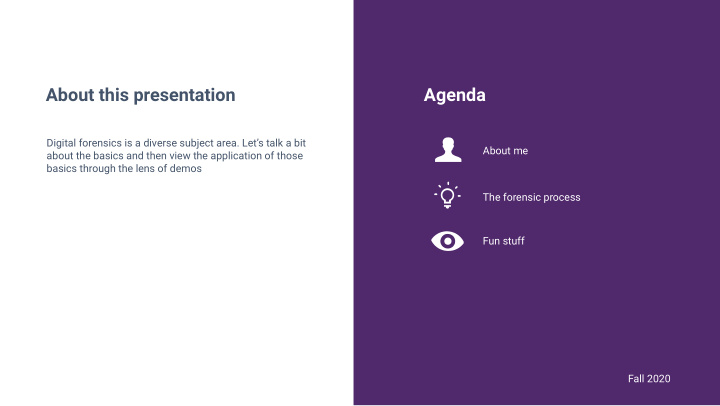



1 About this presentation Agenda Digital forensics is a diverse subject area. Let’s talk a bit About me about the basics and then view the application of those basics through the lens of demos The forensic process Fun stuff Fall 2020
About me 2 whoami About Me Education: • Bachelor of Science, Business Administration • Master of Science, MIS Skills Security experience: • Consultant/Senior Consultant, Cyber Risk Strategy services, Deloitte Tech’ • Lead Cybersecurity Consultant, Loptr LLC Risk Dev Professional affiliations: • ISC^2; Certified Information Systems Security Sports Dominic Sellitto, CISSP Professional (CISSP) • Buffalo Electronic Crimes Task Force vCISO Publications: • Vulnerability Assessment (ISACA, 2017) Hats worn: • Virtual CISO • Project Manager • Security Analyst • Security Monitoring Analyst • Security Architect
Introduction to digital forensics 3 What is digital forensics? Digital forensics is “the application of science to the identification, collection, examination, and analysis of data while preserving the integrity of the information and maintaining a strict chain of custody for the data." - NIST SP 800-86, Guide to Integrating Forensic Techniques into Incident Response (Pg. 15) Digital forensics may also be referred to as: • Computer and Network forensics • Data forensics
Introduction to digital forensics 4 Phases of the forensics process NIST 800-86: Guide to Integrating Forensic Techniques into Incident Response describes the 4 phases of the forensics process as follows: Collection Examination Analysis Reporting Source: NIST 800-86: Guide to Integrating Forensic Techniques into Incident Response
Introduction to digital forensics 5 Enabling factors In order to repeatably execute the process, you need some things… Governance: Finances: Collection Policies Tools (licensing) • • Procedures Technologies • • Standards Training • Examination • Analysis People: Reporting Location: Investigators • • Lab / room • IT professionals Access control • • Incident response team Monitoring • In-house vs. outsourced • Source: NIST 800-86: Guide to Integrating Forensic Techniques into Incident Response
Introduction to digital forensics 6 Forensic areas of practice You might just think of forensics as examining hard drives, but it’s much more than that: Media forensics Malware analysis Memory forensics Network forensics Mobile forensics Cloud forensics Email forensics Digital media manipulation IoT forensics Automobile forensics
Introduction to digital forensics 7 Network forensics Packets contain all of the information being sent across a network, including the source and destination machine, protocol being used, and the actual data being sent. Network logs are records of network events— they tell you that something happened over the network (like source, destination, protocol) but do not contain the actual data that was sent.
Introduction to digital forensics 8 Network forensics: Wireshark Let’s talk about Wireshark…
Introduction to digital forensics 9 Digital media manipulation Which of these is fake?
Introduction to digital forensics 10 Malware analysis… What’s that program really doing?
Introduction to digital forensics 11 Email forensics… Oh look, a phish !
Recommend
More recommend